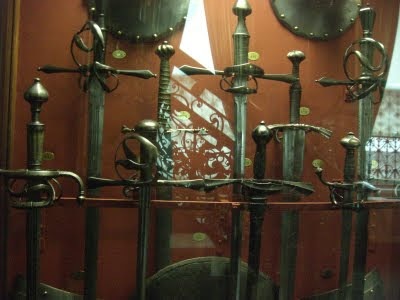This is a picture of Jake regarding a plaster cast of a doorway do the Urnes "stave church" in Norway, built of wood and intricately carved with curvilinear beasties, characteristic of this the twilight of pre-Romanesque Scandinavian ornamentation.

As we talked about the themes, motifs, styles and depictions, Jake also pointed out to us the marks of workmanship, and with out little bit of experience we could see how the wood had been carved.

This is the base of an Irish "high cross", showing influence of Viking and Anglo-Saxon ornamentation in its design, resulting from the Norse settlement of Ireland in the eighth through tenth centuries.

Below is a runestone of the blockier, swirlier, chunkier "Ringerike" style of Norse art, depicting intertwined dragons.

One find common in populated places which must have featured workshops are these so-called "trial pieces", pieces of bone or some other carvable material where craftsmen and students alike would work out patterns, practice techniques, and test new ideas, which we spent a considerable amount of time doing.

Later in the day we ventured to the Wallace Collection, still in London, which is one of the largest and most staggering collections of historical arms and armor in the world, predominantly blades.
The pictures below are both from there and from the British Museum. This first one is an Anglo-Saxon sword, probably pattern-welded iron and steel, although corrosion is not kind to ferrous metals. Most striking now is the bronze scabbard throat, wrought of bronze, most likely lost-wax cast by a Saxon craftsman.

These are some exceedingly beautiful bronze and gilded-bronze sword pommels. Their minute and exquisite workmanship puts them on par with the so oft-touted Irish metalworking like the Tara Brooch and the Ardagh chalice.

Below are iron Celtic swords of the continent, with beautifully preserved scabbards.

This is the exceedingly ornate boss of the Sutton Hoo shield, made of iron and covered with fine bronze foil, which was hammered by a master craftsman onto carved dies and then riveted onto the larger piece.

Blades from many periods and cultures congregated at the Wallace Collection, all with unique and equal beauty.


No comments:
Post a Comment